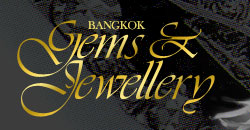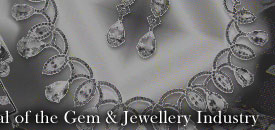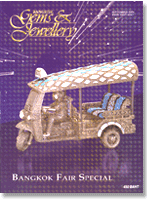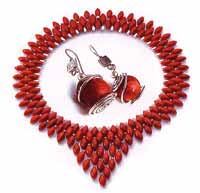 The word coral brings to mind magnificent coral reefs of Australia
(Great Barrier Reef) or the Pacific Ocean. These are indeed great
underwater forests branching out like trees or in the shape
The word coral brings to mind magnificent coral reefs of Australia
(Great Barrier Reef) or the Pacific Ocean. These are indeed great
underwater forests branching out like trees or in the shape  of
large filigreed fans in beautiful colours.However, the coral under
discussion here is the gem variety, which by and large is restricted
to two major varieties, namely Corallium Rubrum and Corallium Japonicum.
Like pearls, corals belong to the organic variety of gems. Also, like
pearls, corals are largely made up of the same material, that is carbonic
lime, which makes up roughly 90% of the gem. Before we begin a description
of the physical necessary to explain, what it is exactly. Coral is
actually the skeletal deposits of a marine animal called the coral
polyp. Coral polyps build their limestone skeletons by taking calcium
out of seawater. They then deposit the calcium carbonate (limestone)
around the lower half of the colony. As each generation of polyps
die, the next generation continues to build on top of its predecessors.
As new polyps grow, the of
large filigreed fans in beautiful colours.However, the coral under
discussion here is the gem variety, which by and large is restricted
to two major varieties, namely Corallium Rubrum and Corallium Japonicum.
Like pearls, corals belong to the organic variety of gems. Also, like
pearls, corals are largely made up of the same material, that is carbonic
lime, which makes up roughly 90% of the gem. Before we begin a description
of the physical necessary to explain, what it is exactly. Coral is
actually the skeletal deposits of a marine animal called the coral
polyp. Coral polyps build their limestone skeletons by taking calcium
out of seawater. They then deposit the calcium carbonate (limestone)
around the lower half of the colony. As each generation of polyps
die, the next generation continues to build on top of its predecessors.
As new polyps grow, the 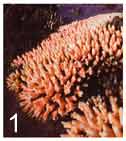 limestone
formation gets bigger and bigger and form the branchlike structures
of the coral stems. They can grow up to around 40
cm, but the branches rarely ever grow thicker than a few centimeters.
It is only at the forks of the branches that they are thicker, and
it is normally from these parts that the valuable gem material is
harvested. limestone
formation gets bigger and bigger and form the branchlike structures
of the coral stems. They can grow up to around 40
cm, but the branches rarely ever grow thicker than a few centimeters.
It is only at the forks of the branches that they are thicker, and
it is normally from these parts that the valuable gem material is
harvested.
The fragile coral trees were generally
brought up to the surface by using dragnets. This however, is an ecologically
harmful practice 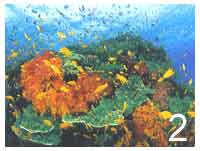 and
has denuded the world's oceans and has driven many species of marine
life to the brink of extinction. Presently, a far more environmentally
responsible method of removing coral is used and today, most coral
is collected by divers. Once up at the surface, the branches are cleaned,
sorted and treated with saws, files and drills. Coral is not cut like
other gemstones.Since coral reefs are among the most endangered ecosystems
in the world, threatened as they are by irresponsible overfishing,
global warming that has driven up the temperature of the ocean's waters,
pollution, bacteria, etc., it is estimated that in the future coral
will be in short supply. Many countries have therefore appslied restrictions
on the harvesting of coral and its import and export. Japan for instance,
has imposed strict quotas, the United States requires permits for
importing coral. Today, a certificate from the country of origin is
the norm before coral can be exported in any form. Ban on the export
of coral from the Phillipines, which was once one of the leading suppliers,
led to the emergence of Indonesia as the and
has denuded the world's oceans and has driven many species of marine
life to the brink of extinction. Presently, a far more environmentally
responsible method of removing coral is used and today, most coral
is collected by divers. Once up at the surface, the branches are cleaned,
sorted and treated with saws, files and drills. Coral is not cut like
other gemstones.Since coral reefs are among the most endangered ecosystems
in the world, threatened as they are by irresponsible overfishing,
global warming that has driven up the temperature of the ocean's waters,
pollution, bacteria, etc., it is estimated that in the future coral
will be in short supply. Many countries have therefore appslied restrictions
on the harvesting of coral and its import and export. Japan for instance,
has imposed strict quotas, the United States requires permits for
importing coral. Today, a certificate from the country of origin is
the norm before coral can be exported in any form. Ban on the export
of coral from the Phillipines, which was once one of the leading suppliers,
led to the emergence of Indonesia as the

world's leading exporter during the 1990's. Since
1995, coral exports from countries like Mozambique, Tonga, Fiji and
Taiwan have increased. However the gem varieties as well
as sponge coral, pink coral, bamboo and gold corals are not endangered
species, yet. Coral can grow anywhere from depths of between 3 metres
to 3000 metres in the seas around Japan, Taiwan, Indonesia, the Malayan
Archipelago, the Red Sea, the Canary Islands, Northeastern Australia,
the Midway Islands, the Mediterranean Sea, the Tyrrhenian Sea, off
the coasts of Sardinia, Tunisia, Algeria, Yugoslavia -
1.Bleached coral
is white due to the loss of the brown symbionts that normally populate
its tissues. Although white, the coral tissue still persists, even if
the symbionts have largely disappeared.
2.A living coral reef is absolutely magnificent to behold. These splendid
creations of nature are now being threatened by overfishing, global warming
and pollution among other factors.
3.Coral carvings are an intricate artform and are especially prized in
the Far East Asian countries.
4.Bleached coral can often take on bright attractive colours due to the
coral pigments that are left behind. In this photo, pink coral pigments
dominate the otherwise white tissues.
Turkey, the Hawaiian Islands and the South Pacific
are the main areas. In all, around sixty four nations export gem coral
in some form. The leading consumers of coral are the United States and
Japan.Although, the word coral is usually associated with the colour
red, they are not necessarily of this colour. Red is however one of
the most coveted shades. All the red shades,
from deep velvety red, to orange red,

salmon pink, pale pinks to the almost white with a
blush of pink called Angelskin coral are all considered among the fine
colours of this gem. Angelskin coral in fact, is among the more valuable
species of this marine gem as are the deeply satiated red Moro coral
from Japan and the pale pink Boke and the red Sardena. Currently though,
fashion is showing a remarkable inclination towards black coral, golden
coral and a very rare variant, the blue coral. Lighter in weight and
less expensive than these fine corals are the Root Coral and Foam Coral.
Root corals are in fact a different coral species rather than a simple
root. It is a special kind of coral bush
and is not a part of the other types at all. Foam coral on the other
hand is the part that lies between the foot and the stem of the Japanese
Moro coral and is usually found embedded in the mud of the sea floor.
Foam coral weighs more than Root coral and is more expensive as well.
Both kinds are available in large quantities and are supplied by China
and Japan. When unfinished and still in its natural state, coral is
quite dull and sports a matte look. Once it is polished though, it acquires
a high polish and a beautiful gleam. Good quality coral should have
an even colour and should have no spots, bands, fissures, cracks and
other blemishes. As it is porous by nature, it is liable to have cracks
and fissures and these specimens are of a lower quality than the finest
blemish free pieces. The look of the gem is usually improved by the
application of a coloured wax that enhances its appearance.Genuine untreated
coral is actually quite rare and unless you are buying it from a very
reputed trader, you ought to assume that the goods you are buying are
enhanced. As with every other gemstone, disclosure of treatments remains
a problem in the hands of

unscrupulous dealers. Like with all other gems, coral
too has its imitations. These are usually made of conch shell
and compacted powdered marble. Plastic, wood and wax are also used in
the manufacture of imitation material. Coral's specific gravity falls
between 2.6 - 2.7 and it has a texture akin to wood grain. Its refractive
index lies between 1.486 - 1.658. It has a hardness of only 3 - 3. 5
on the Moh's scale and thus is especially fragile.
Therefore it needs to be protected from scratches or even sharp impact.
Coral also needs to be kept away from large temperature change as this
will damage the stone. As it is basically made up
of calcium carbonate, coral will
5.In many African
tribes, coral is thought of as a gift of royal proportions.
6.These are some natural coral branches before it has been made into various
shaped beads. On top natural black coral and in the middle a couple of
small natural sea bamboo coral segments. The bottom is actually black
coral turned into gold coral through a special secret treatment, not dyed.
This is what gold coral looks like before it becomes a bead.
effervesce
if brought into contact with acids or even one as mild as vinegar. In
fact, it needs to be kept away from most chemicals and even cosmetics
especially perfumes will damage it. Therefore chemical cleaners should
be avoided, as should ultrasonics and steam cleaners. The best way to
clean coral jewellery is to wipe it with a soft, moist cloth. If however,
in spite of all the care, the coral does get scratched, there is no
need to worry. A good jeweller can polish it up again.It is basically
cut into beads, cabochons, carvings, and other ornamental objects. In
fact, coral is the hot fashion favourite for 2004.

Normally, it can be teamed with either gold or silver,
and other beads and gems in warm colours. Coral is also sometimes combined
with Chinese freshwater pearls, and its combination with turquoise is
an American favorite that harks back to native American jewellery. Native
Americans have prized this gem for more than four centuries now. Coral
is not a modern gem. It has been used for not just centuries but millennia.
It has been known to mankind since Paleolithic times and coral has been
found with Paleolithic remains. Coral was 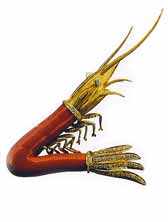 very
popular with the ancient Greeks and Romans as well. Greek mythology
claims that it originated very
popular with the ancient Greeks and Romans as well. Greek mythology
claims that it originated 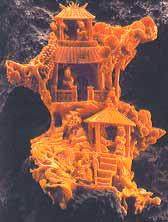 with
Medusa's death at the hands of Perseus and that the drops of her blood
metamorphosed into red coral. Pliny has recorded a regular trade in
this gem between India and the Mediterranean countries in the first
century A.D. with
Medusa's death at the hands of Perseus and that the drops of her blood
metamorphosed into red coral. Pliny has recorded a regular trade in
this gem between India and the Mediterranean countries in the first
century A.D.
Coral inlays and ornaments have been found in Celtic tombs from the
Iron Age. The Romans used it as a cure for snake bites and scorpion
stings and believed that it would protect their children,therefore in
Roman times it was a popular gift for newborn children. They also believed
that a dog collar made of coral would prevent rabies. In parts of Africa,
strings of coral beads were considered to be a gift of royal proportions.The
very root of its name is still puzzling many linguists. Some are convinced
that it comes from the Greek word Korallion as this signifies the hard
and calcerous skeleton of the coral polyps, others say that it could
be derived from Kura Halos meaning mermaid. Some say that it comes from
the Hebrew word Goral, which was the name for stones that were used
to cast an oracle. The fact is that in ancient times coral branches
were used to cast oracles in Palestine,


the countries of Asia
Minor and the Mediterranean. All three are plausible explanations
and the debate continues. Despite the fact
that coral was rare among the reefs off the coast of India, since ancient
times, Indian civilization has accorded it a great deal of religious
and astrological significance. According to Indian astrology, coral
is aligned to the planet Mars, which is the field of activity, energy,
courage, ambition, sports, property, strength, leadership, technical
and mechanical abilities, and forcefulness. It was thought to be a strong
talisman against bleeding, evil spirits and hurricanes and have the
ability to cure madness or depression and confer wisdom. It is also
said to affect the genitals and work with me immune system to cure many
diseases.
Other cultures too attach religious significance to this
marine gem. It is said to be one of seven treasures according to Buddist
scriptures and was extensively made use of by Tibetan lamas in their
rosaries. It was widely used as ornamentation in the Islamic regions
of Asia from Turkey to Uzbekistan and in these two countries, it was
set in ladies headdresses in centuries past. The path followed by Alexander
the Great in his conquest of Central Asia became one of the major trade
routes and was used till



7.Coral lends itself marvellously
to asymetrical shapes and odd sizes. It can be carved into cameos,inlaid
and is versatile enough to be used in all kinds of jewellery in every
price range from low end to the high end designer stuff.
the Middle
Ages. Coral was often transported down this commercial highway from
Asia to Europe.
In 1805, Paolo Bartolemeo Martin opened a factory
for working
on coral in Torre del Greco, which is south of Naples in Italy. This
centre flourished and cameos from this area were very popular in the
19th century. The coral industry in southern Italy really thrived during
the rule of the Bourbons and Joseph Napoleon and Joachim Murat. Around
three quarters of all the coral that is harvested is processed in Torre
del Greco.
Whatever its historical antecedents may be, coral
is very much a hot gemstone today. Fashion has deemed it the colour
for spring - summer this year and come winter, its popularity seems
very unlikely to fade. Famous jewellery designers like Henry Dunay have
used it extensively in their creations and it is true that the presence
of coral in a piece of jewellery imparts to it a certain amount of energy
and vibrance and this in turn is transferred to the wearer of the gem.
Although, it is termed a semi precious gem, and the lower grades of
coral are extremely cheap, fine naturally coloured specimens that are
unblemished and innocent of any enhancement are rare and expensive.
Also supplies are not unlimited, although it may seem that it is a self
replenishing gem, current environmental hazards have had extremely detrimental
effects on its sources. Coral is also an extremely slow growing organic
material, often registering only W or 1/2 inch growth in a year. Therefore,
it is quite possible that there will be a time in the future when the
world's supply of this gem dries out and this treasure of the sea will
no longer be available for the contemporary generation to wear and enjoy.

|
